How to create an automated facebook chatbot flow
SendPulse allows you to create automated Facebook chatbot flows when a bot provides subscribers with some information according to a pre-determined scenario.
The flow builder is the main tool to set up your bot to welcome new subscribers, assist users, sell products, and notify a manager about users’ questions in the chatbot. Also, a chatbot can gather information and send it to your system for future use. All you need is to create keywords, design the bot’s structure, and drag-and-drop elements in the SendPulse flow builder.
It’s important to think about the architecture and logic structure of your bot carefully. A well-designed bot will let users easily get a reply to their questions or place an order successfully by providing the necessary information.
Choosing a trigger for your flow
By default, there are Welcome message, Standard reply, and Unsubscribe from bot flows. And you can create your own new triggers to get more functionality.
Choose your bot. Go to the Bot Structure tab and choose a trigger.

Welcome message flows
The flow starts after a user subscribes to your chatbot.
This flow introduces your bot to users. Here you can write about your bot and its features - how the bot can be useful, what information bot can provide, and how often bot will send messages and the content of those messages.

Standard reply
The flow will launch in response to any user question that is outside your bot’s scenario, or by sending an image to a bot. Here you can add a message with information, that a manager will contact during them during business hours and reply to the user.
You can set up a cool down interval for launching a flow that is between 1 minute and 24 hours - so your bot won’t launch a second time within the specified interval.

Unsubscription from bot
This a flow with one message element that will launch after a user unsubscribes using the /stop or /unsubscribe command.

Trigger flow
You can add keywords - triggers, that your bot will react to and launch your flow.
Click Create a new trigger. Select a trigger type. For Keyboard type write your command using one or several words. For example, you can use the words Order, Tickets, Price, or Delivery.

If the user enters part of a keyword linked to your command, your bot will suggest prompts such as a button with the name of your trigger. When the user clicks the button, the flow will launch.
To disable this feature, go to your chatbot settings and select the Disable bot suggestions when entered messages do not match a keyword option.
Building your flow
It’s important to think about the architecture and logic structure of your bot carefully. A well-designed bot will let users easily get a reply to their questions or place an order successfully by providing the necessary information.
Formulate the bot’s tasks, divide its functions into sections, think of how you will connect the elements, and start creating your bot’s flow using our drag-and-drop builder.
All the elements available in the builder are optional, you can even stop building after the first message element.
We recommend checking out the different varieties of chatbots and strategies for building your bot on our blog.
Start
You can choose the first element that launches your flow: Message, Filter, Randomizer, and API Request.
For example, using the Filter and API Request elements, you can check the subscriber's data and personalize your communication by starting your flow only for those users who have or do not have the requested data or branch your flow and send different messages. Using the Random choice element, you can diversify your chatbot's auto-replies or create an A/B test.
To make an element a start element, connect the desired element to the Start.

To see which trigger starts your flow, click on the Start.

A Message element
Using the Message element, you can create a message of any type and add various blocks to it: text, video, gallery, buttons, user data request, and so on.
Text
Within the Message element select the text element type and add the text of your message. Also, you can add emoji and variables to personalize your messages.
To add a variable click {} in the right corner of the text block and choose the variable you want to add from the drop-down menu. If you have a value for this variable in the user’s contact information, they will receive a message with the value filled in.
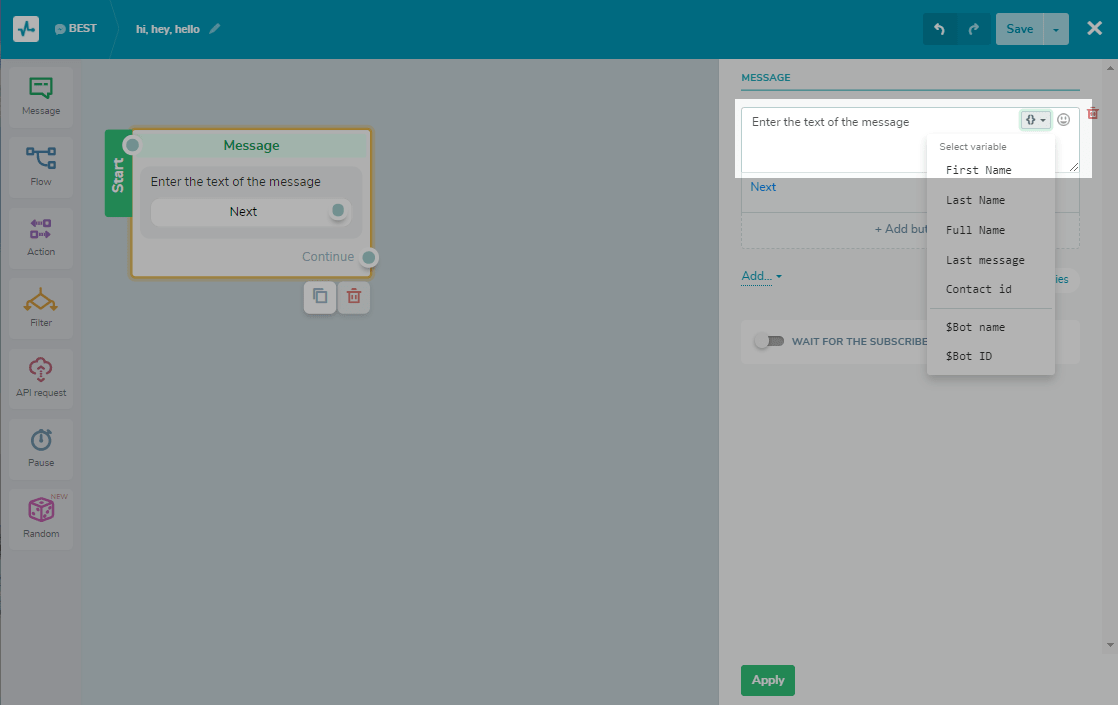
You can add the following types of variables.
| Custom variables for contacts | You can transfer variables when a user subscribes to your chatbot. Set and update variables manually in the Audience section. Set and update variables automatically in a flow using the Action - set variable, User input, and API request elements. |
| System variables | You can insert the text of the last message from your subscriber using the last_message variable. You can also add a subscriber ID using contact_id. |
| Global variables | You can create your own variables in your bot settings and use messages with predefined values that will be shared with all of your subscribers. By default, $bot_name, $bot_id, and $current_date are available. |
Buttons
You need to add a button or user input element to the message element if you want to connect it with other elements in your flow. This is one of the most important elements for communicating with your users - buttons engage users and let them chose a direction for your bot to take them to the next part of your flow.
Click + Add button to add a button to the message.
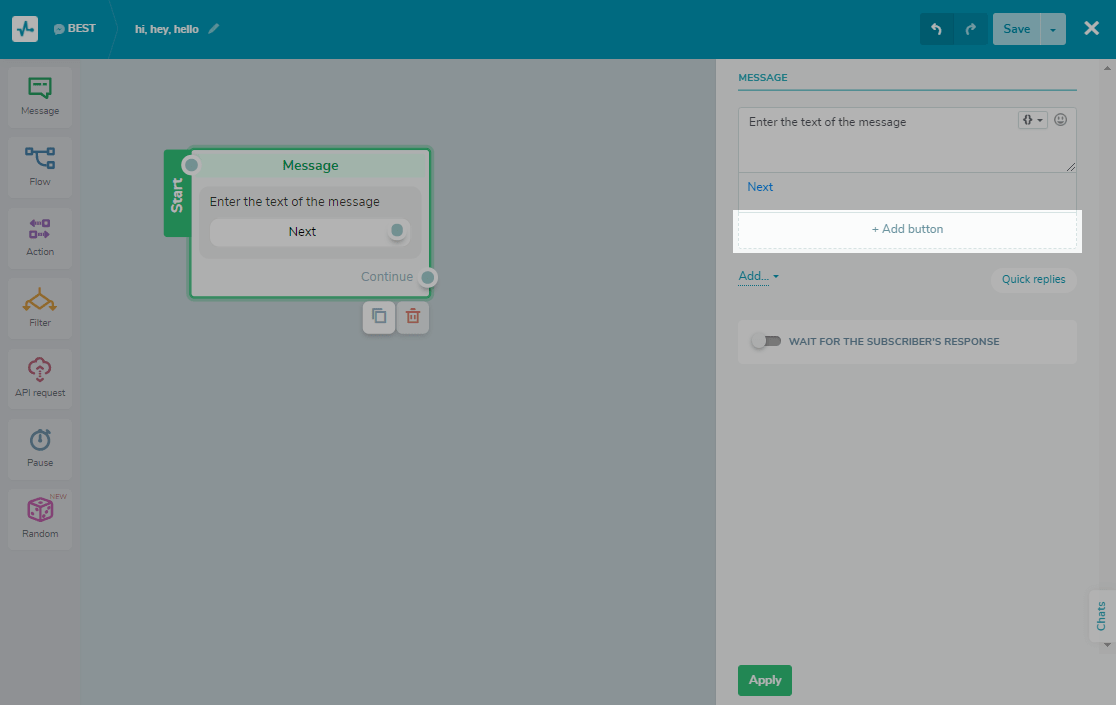
Select the type of button: Continue flow, Link or Payment.

Name your button in the first field. You can add up to 20 characters and emoji to the button’s text.
The text on the button should be easily understandable - it’s important for users to understand what will happen when they click on the button and know what specifically they need to choose. Make sure that the next element in your flow corresponds to what the button says it will do to maintain the logic of your bot.
For a button with the Link type, you can also attach a link to a third-party resource. Your link can contain up to 512 characters.
To allow the user to continue the conversation by clicking on the link button, you need to activate the Link Tracking option in the chatbot settings under the General tab.
After the button details are set, click Add.
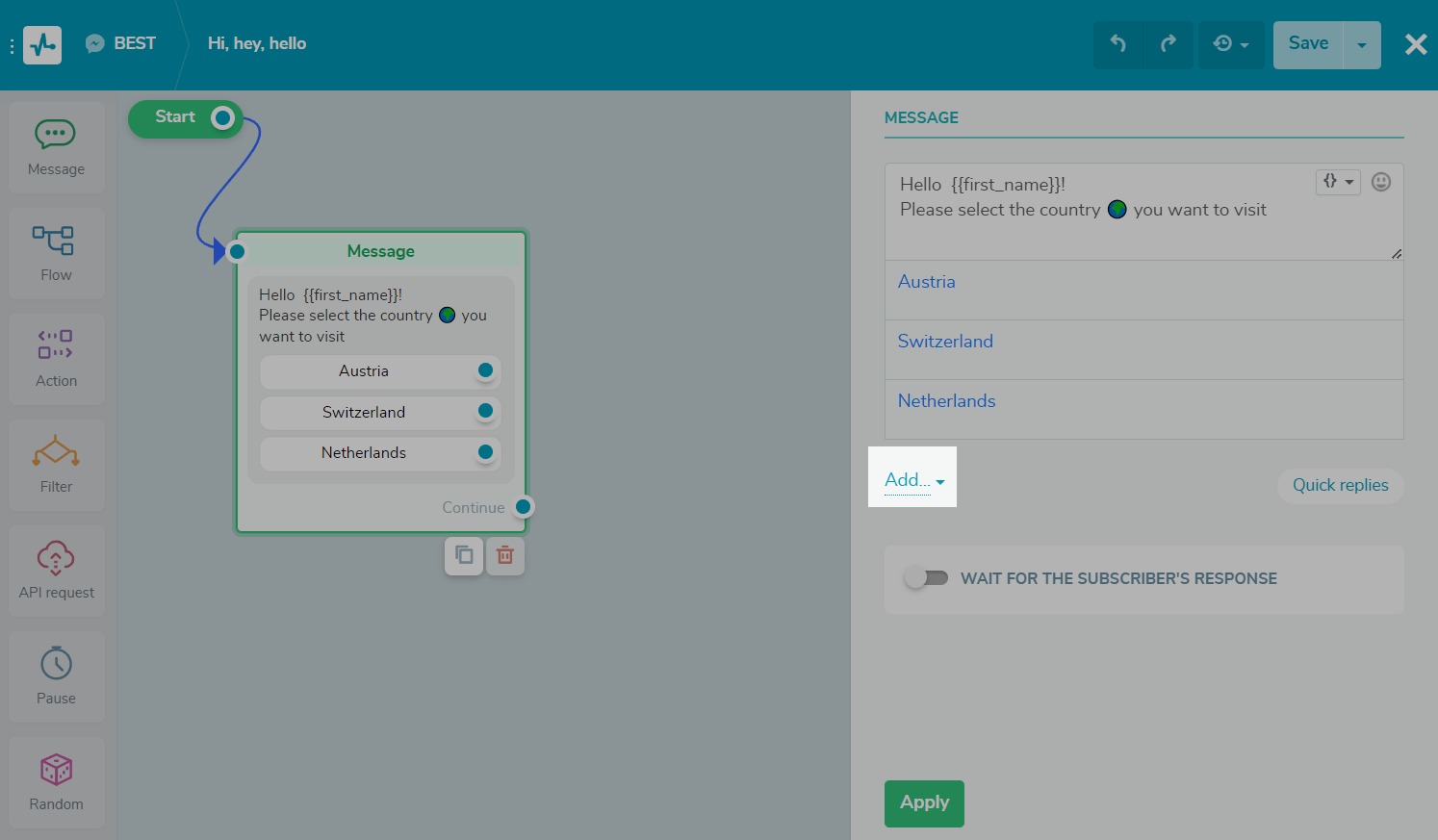
We recommend adding “Back” and “Back to main” buttons after all the information you add, so users can change their choice and choose another path through your flow. This prevents the logic of your bot from being trapped or broken with one message.
You can add no more than three buttons under one element.
Images
Diversify your messages by using visual content that relates to your text.
Click the Select file button to upload an image from your computer or device, or drag and drop a file into the upload field.
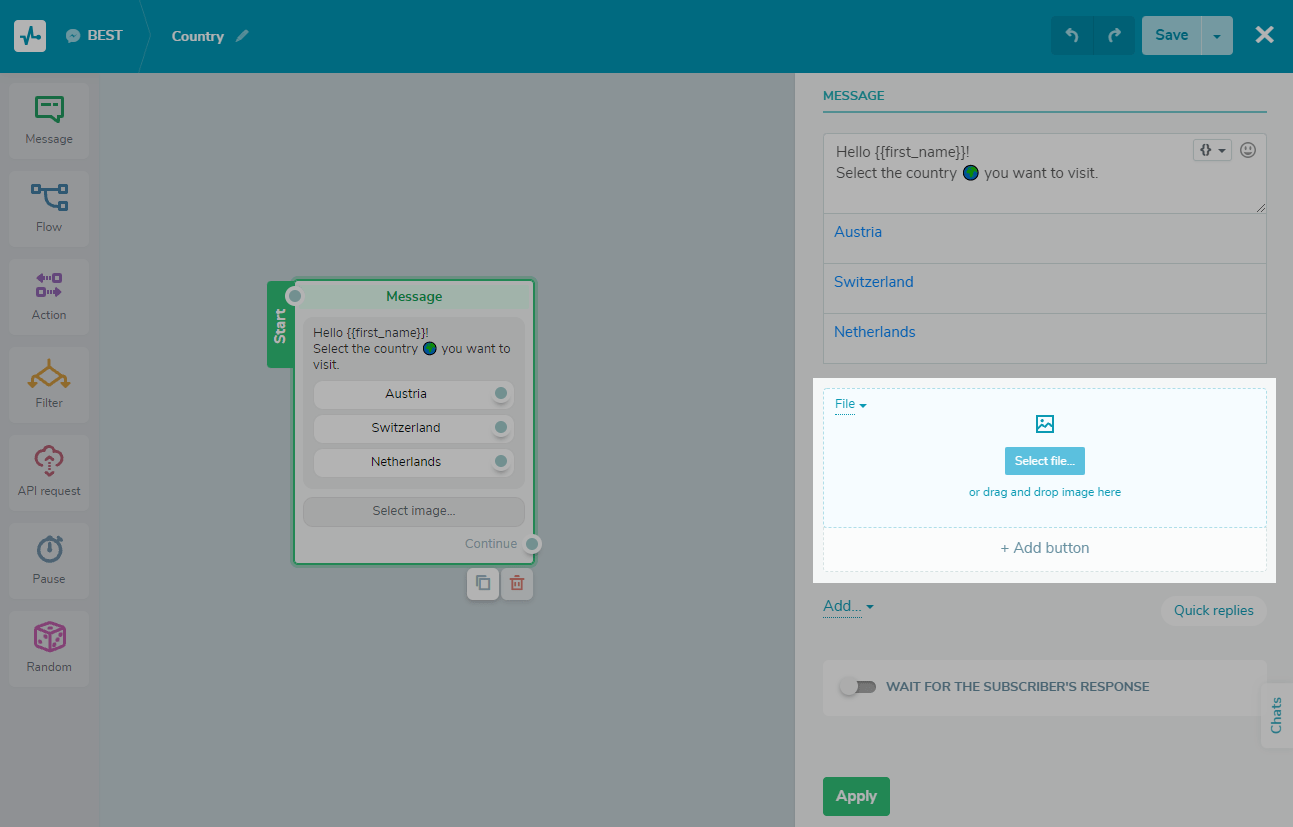
For better display in Messenger choose an image resolution of 500px in width and 200px in height. It looks both good for desktop and mobile apps.
To upload an image from a link, select Upload image by URL in the drop-down menu and specify the link to the image in the field.
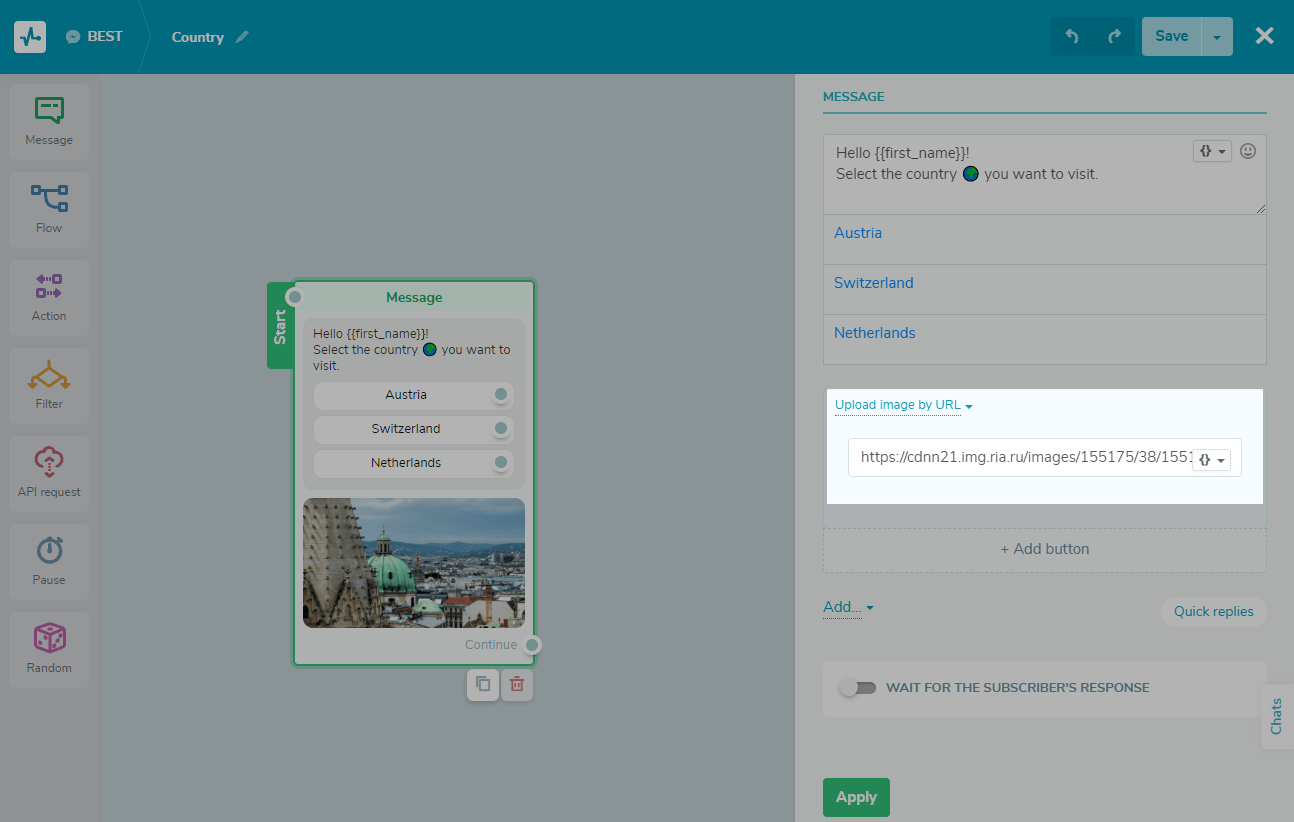
You can also specify a dynamic path to the image. For example, using the API request element or from the a360 event, launching the flow via API, you can send a product picture and use this variable in the following message, displaying order data to the client.
To do this, select a variable or specify a JSON path in the field and pass the path to the image in the variable's value. Thus, each client will receive an image according to their order.
Сards
The carousel format allows you to showcase up to 10 cards. In one card you can add an image, title – with up to 40 characters, description – with up to 80 characters and 3 buttons with link to an external source or with a phone number to call. To add more cards click + on the right.
The service allows you to add up to ten cards in one element. To switch between the cards, click the arrow buttons. To delete a card, click the cross button.
If you add two or more cards in the editor field, they will show up in a row and go beyond the block.
File
You can add files in any format excluding executable files, with a size of up to 5 MB. Attach your brochures, tickets, commercial proposals, or other additional media.
Click Choose File to upload a file from your computer or device, or drag and drop a file into the upload field.

To upload a file via a link, choose Upload file via URL from the drop-down menu and specify the file’s link in the field.
You can also specify a dynamic path to the file. For example, if you use the API Request element, or launch a flow from an A360 event or via the API request, you can send a file and use this variable in the next message when displaying order data to the customer.
To do this, select a variable or specify the JSON path in the field and pass the file path in the variable value. Thus, each customer will receive a file linked to their order.
Media: Audio and Video
You can also add audio and video messages to your flow scenario. Maximum upload file size — 20 MB.
Thus, you can attach video lectures and voice consultations directly in the bot without sending the user to third-party resources.
Delay
Divide long texts into passages up to 4 lines with the Delay element. This element will imitate typing by showing the typing animation and gives your user a rest before the next message.
Click the Add button and choose the Delay element. Enter a value in seconds - from 1 to 5.
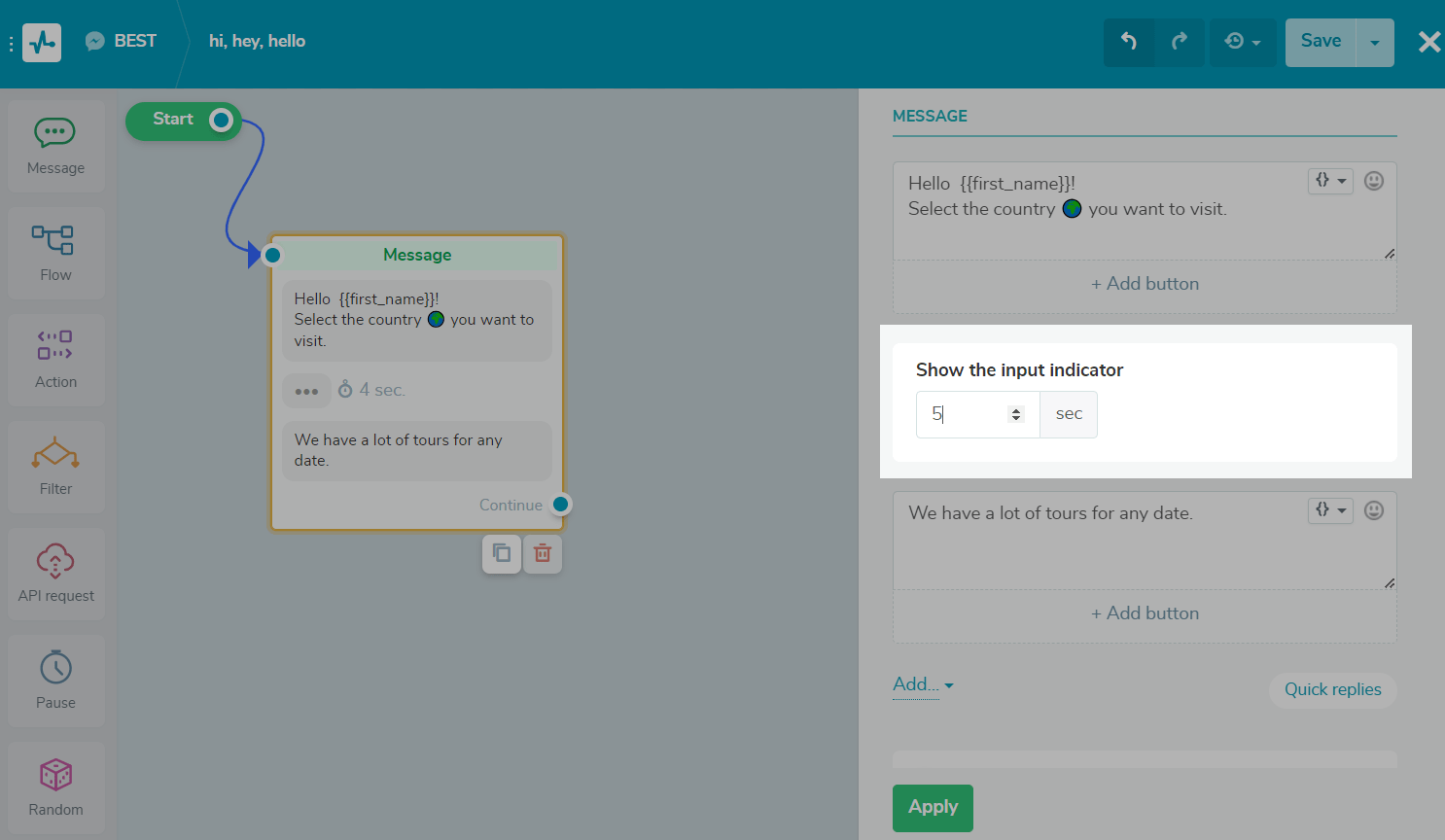
A message is not sent when the indicator is shown. Correlate the time of typing and the size of the message it is displayed before.
User Input
You can gather information from users and save it to a variable for future use. Users can enter any value, and you only need to set up the type of validation for this value, e.g., string (for text values), number, date, phone number, email address, URL, regular expression, or image or document.
Activate Wait for the subscriber's response. Choose the validation type, add a warning message for users who enter the wrong value, and choose the variable where you want to store information.
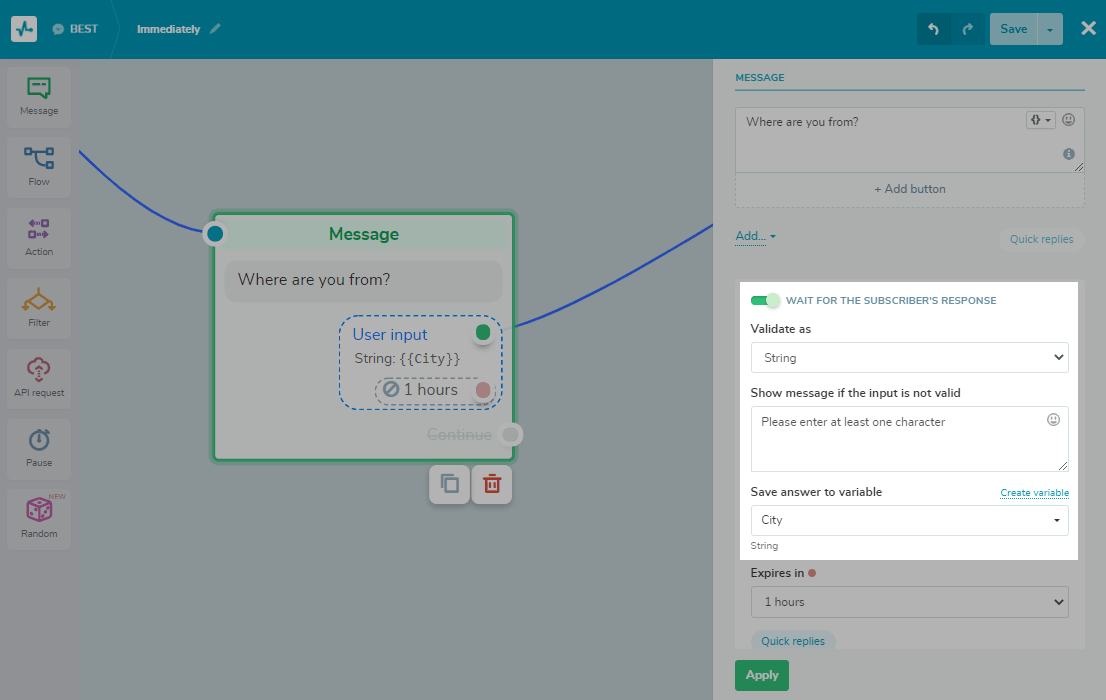
The received email address, phone number, and other user data are saved in the automatically generated mailing list from our Email service.
You can also choose the period to wait for a response from the user. If the user does not respond within the selected time, the wait for a response from the user will expire and the chatbot will no longer check the entered data for validity to record user's response.
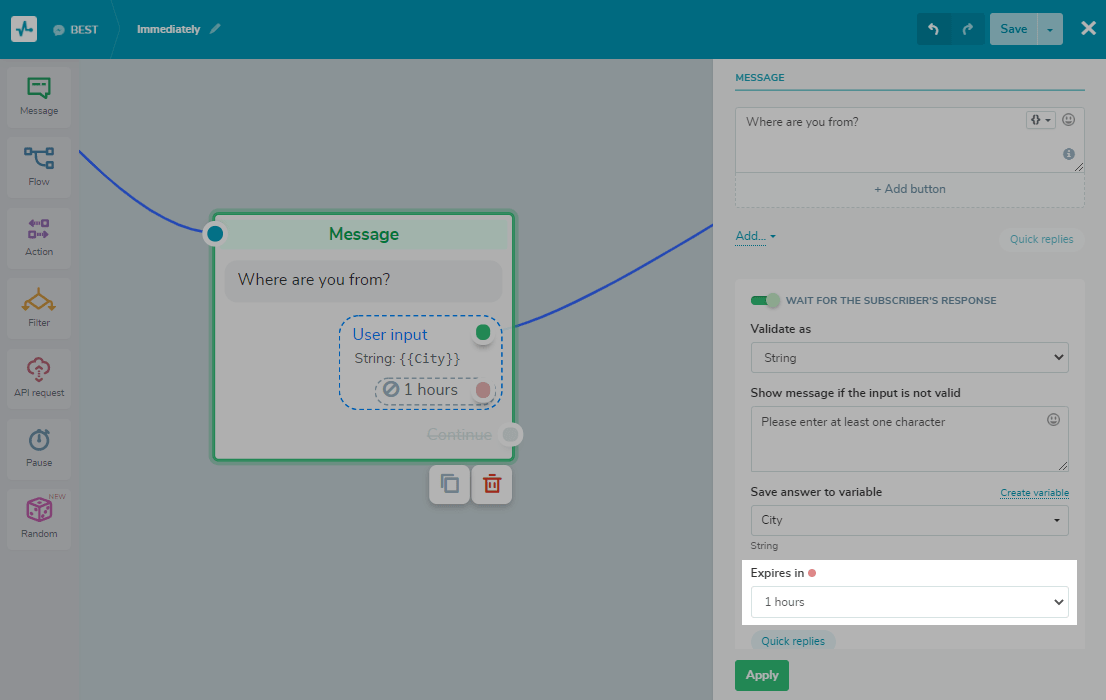
Also, under the message, you can add quick replies buttons – so users can choose from predefined responses instead of typing their own.
Сlick Quick replies in the User input element and enter values for the buttons – you can add up to 10 Quick reply buttons. Quick replies disappear when a user or a bot sends the next message.
Quick replies
Also there is another type of quick reply, this one does not save user’s information – but you can use it to extend the limits of button amounts and tie each button to the next branch of the flow.
Click the Quick Replies button to add a quick reply. Enter text up to 20 characters: emoji or text up to 20 characters. To substitute dynamic values, insert the name of a variable stored in the audience as {{your_variable}}. Press Enter to save the button.
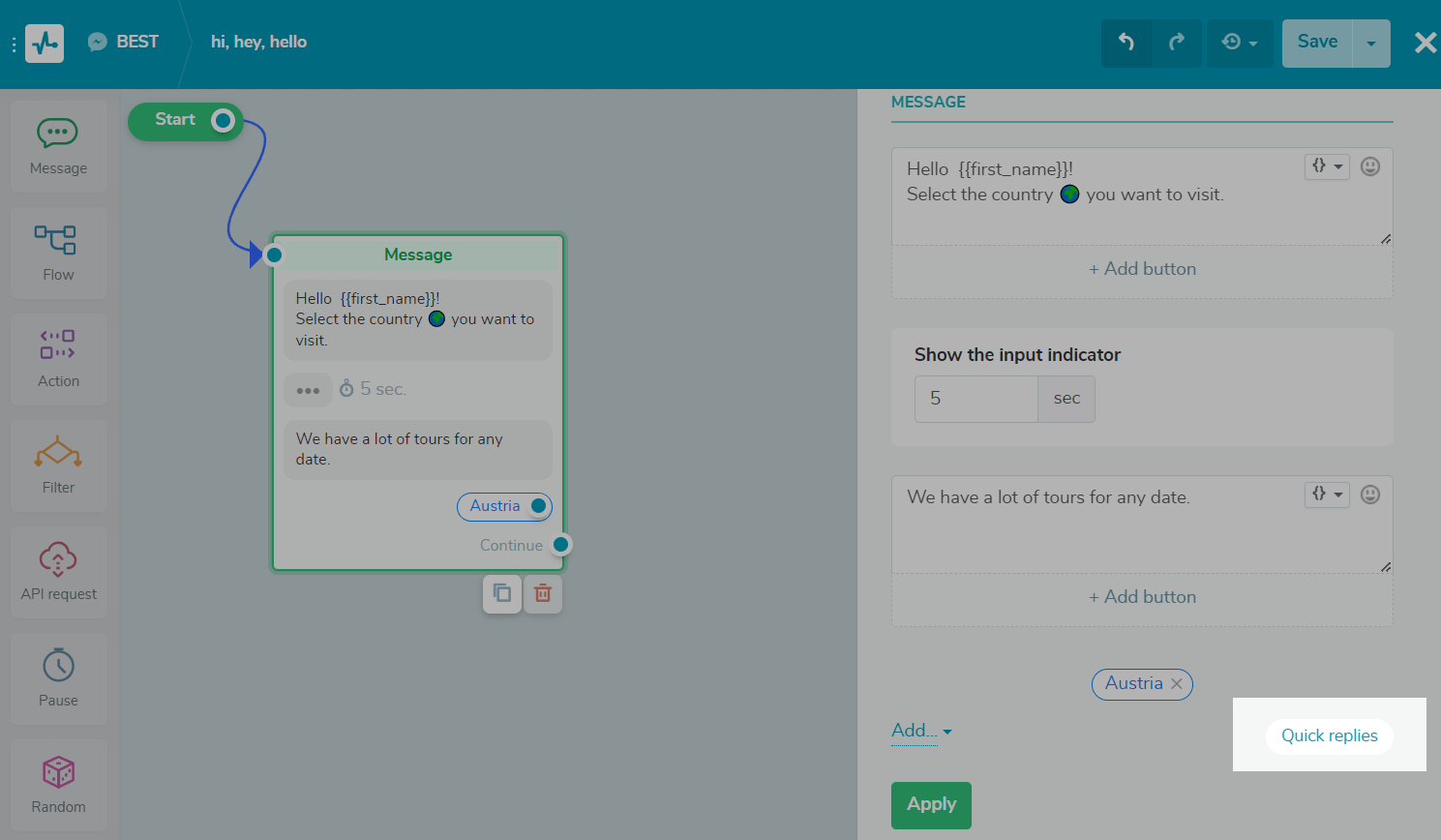
Quick replies disappear when a user or a bot sends the next message.
Continuing the flow
You can connect the next element after the Message element using the button or the User input option. You can also continue your flow without waiting for the user's response. We recommend using it with the Pause element to check if the subscriber interacted with the flow and send a message after a particular time.
When planning a flow scenario, keep in mind that you cannot both continue your flow using the Continue connector and use quick replies.
A Flow element
It allows you to link another flow to the one you are creating. Drag the Flow element to the editor and link it to a button or a quick reply, which will trigger this flow. In the Flow panel, open the Start another flow drop-down menu and select the flow you want to add.
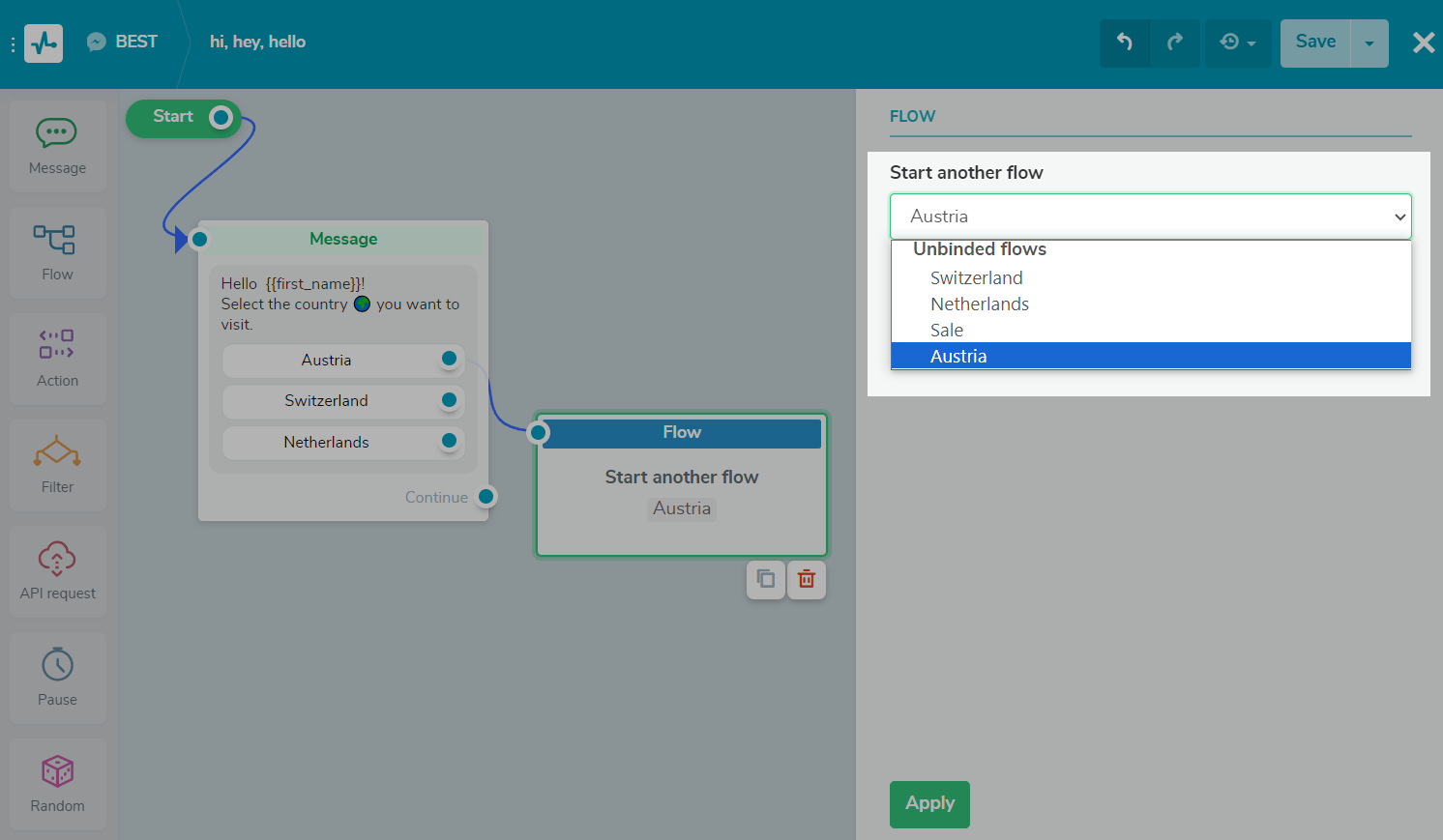
A Filter element
Segment customers based on their personal data and previous messages received. Select the element in the left sidebar, and drag it after the element that will start your script branching.
Then select the condition itself. Combine conditions by adding the operators any or all, or add independent additional conditions.
Read also: How to use the Filter element in the chatbot flow builder.

After adding conditions, add the additional flow elements to each of the Filter element options if the condition is met (green dot) or not met (red dot).

An Action element
The Action element is visible only to you. Select the element in the panel on the left and drag it after the block you're tracking.
Then select what action you want to create:
| Open the chat | Open a chat with a subscriber in the Conversations section |
| Unsubscribe from the bot | Unsubscribe a user from bulk and automated messages |
| Add or Remove tags | Assign a tag to a subscriber, remove a tag assigned to a user |
| Add variable | Set the variable value to be assigned to the subscriber or updated. You can also create a new variable |
| Send webhook | Send a POST request with user data to your URL |
| Create deal | Create a deal in your CRM when a specific action is performed, for example, clicking the "Buy" button |
| Notify me | Send a message on behalf of your chatbot to the system chatbot or Telegram group |
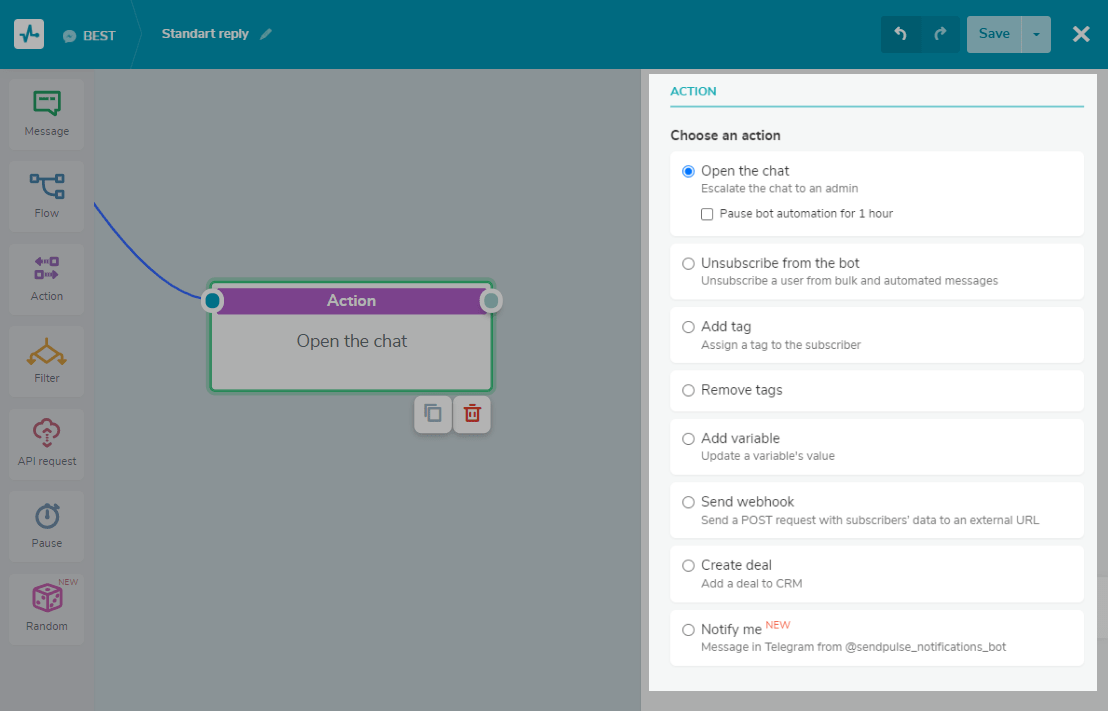
A Pause element
This is the period during which no automatic messages are sent to the subscriber. The pause can be set in minutes, hours, or days.
You can choose to pause in between using the Time period option or until a specific time using the Till time option.
Select the Time period option and set a pause between sending flow elements from 1 minute to 24 hours. Use it in a flow, for example, to warm up a client. After the specified time, the next message will be sent.

Please note: Facebook only allows the following message to be sent after user interaction for 24 hours.
If you select a pause of more than 1 day between elements, you can set the time at which the message will be sent. The system considers the next day any time after 00:00 according to the time zone set in the settings of your personal account.
Also, you can select Till time and set a delay until a particular time. For example, you can use this option to indicate business hours or promotion hours.

Also, using the Pause element, you can set the condition for executing the next element of the flow: always or when the subscriber is inactive.

An API Request element
Send requests to a third party server to create objects or retrieve data. Get data and use it in your chatbot messages.
You can save the received data to a variable or add it to a message as JSONPath.
Drag the API Request element to the workspace, connect it to the element, after which you want to retrieve data. Select the type of request and enter the URL to send the request to.
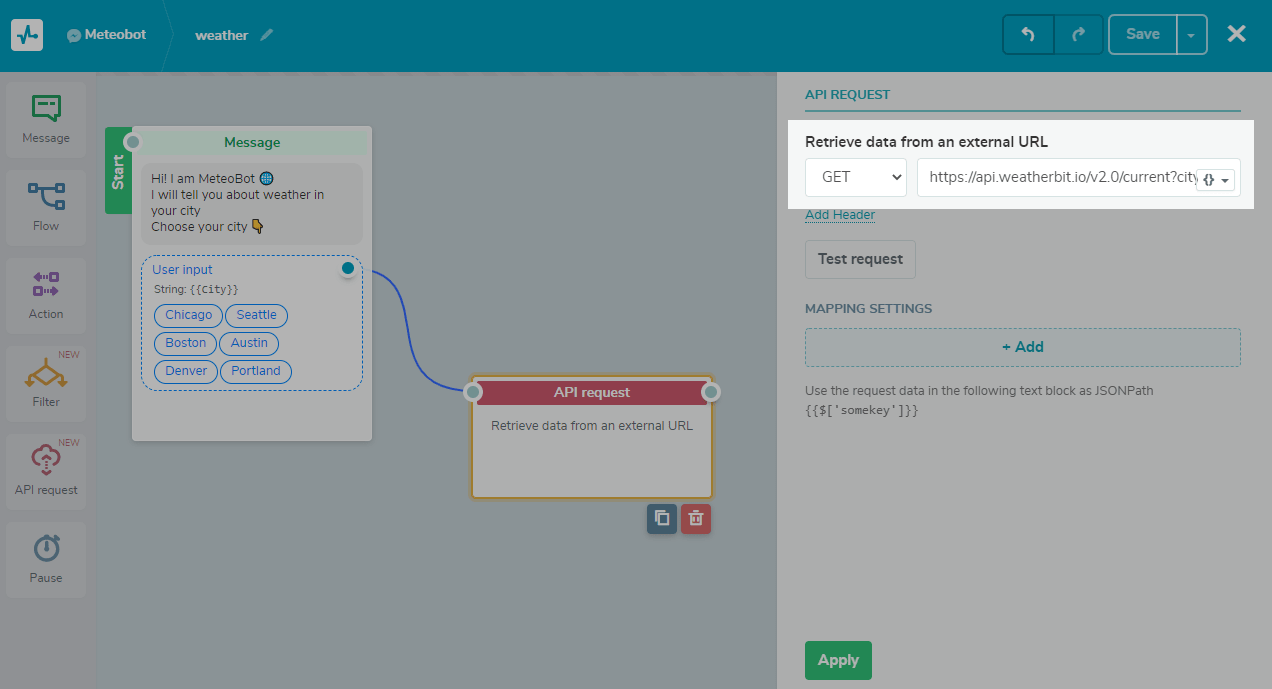
After testing the request and receiving a successful response, configure the mapping settings. If you need to save the value from the response to a variable, select the key from the received request and the variable to save to. If you want to use the received value once without saving it to a variable, copy {{$ ['somekey'] ['nestedkey']}} and use it in the next message element.
Read more: How to send and receive data from external sources
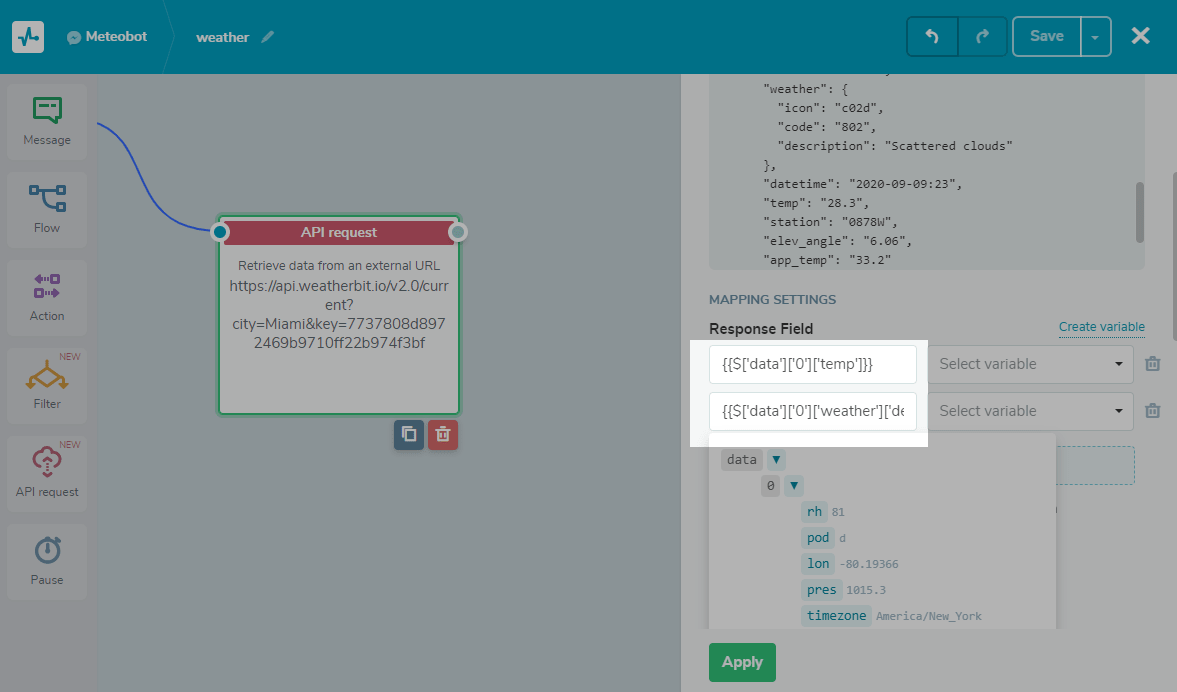
A Random Choice element
Send elements from your chatbot script at random for A/B testing, creating quizzes, and more. You can customize the size of the recipient group for each option and send random information and test different chatbot scenarios.
Drag the item Random choice element to the working area, connect it to the item you start branching the script from.

Adjust the ratio for each option — the percentage of users that will receive each option, or split the flow into equal parts. The higher the value, the more users will get this option.
Save and launch your flow
When you finished creating your flow and have looked over all of the elements, save your flow before exiting. Click Save and send it to yourself to test the flow and check if everything is working correctly.
You can also save an updated version of the flow while leaving the current version unchanged. To do this, click Save as a new flow. The new flow will be saved in the Flows section.
Note: your flow must have at least one Message or Action element.
After that, you can exit your flow by clicking Save and exit.
Managing your flows
You can enable and disable flows at any time by choosing a flow and switching it on or off from your chatbot dashboard.
Disabled flows will have a grey switch.

Analyze your results
SendPulse allows you to track general statistics on a chatbot in the Statistics tab.
You can see the number of messages sent and read, redirects from the flow, both in total and separately for each message in the Bot structure tab.
Last Updated: 28.03.2024

or